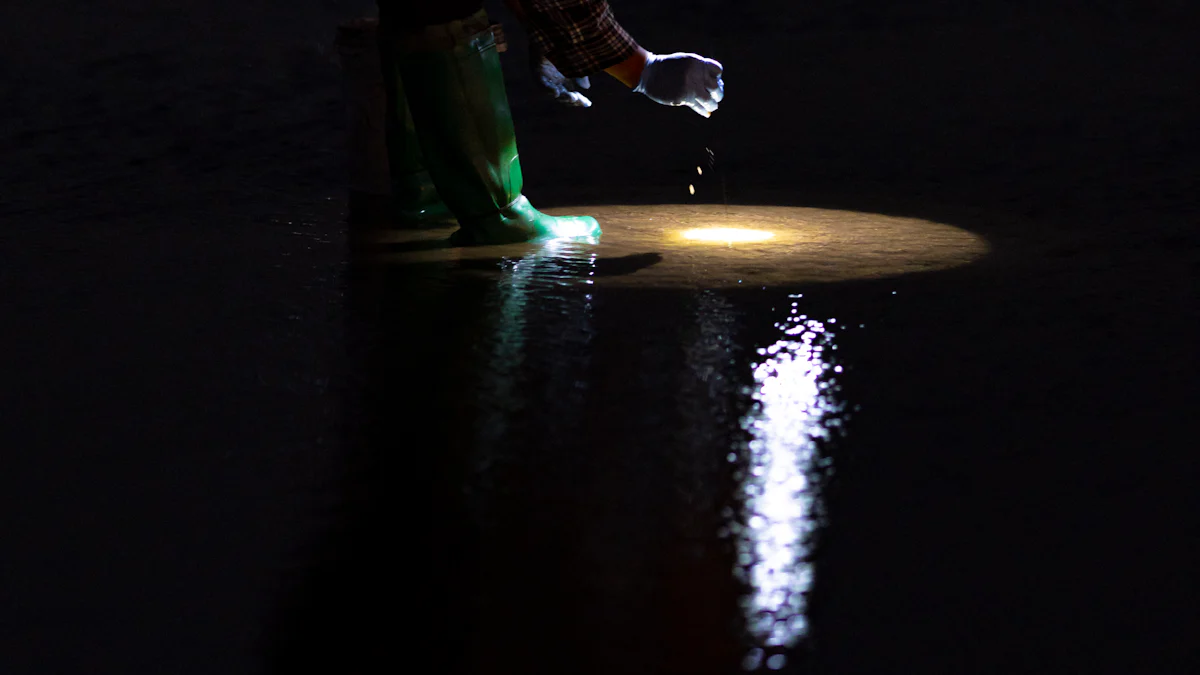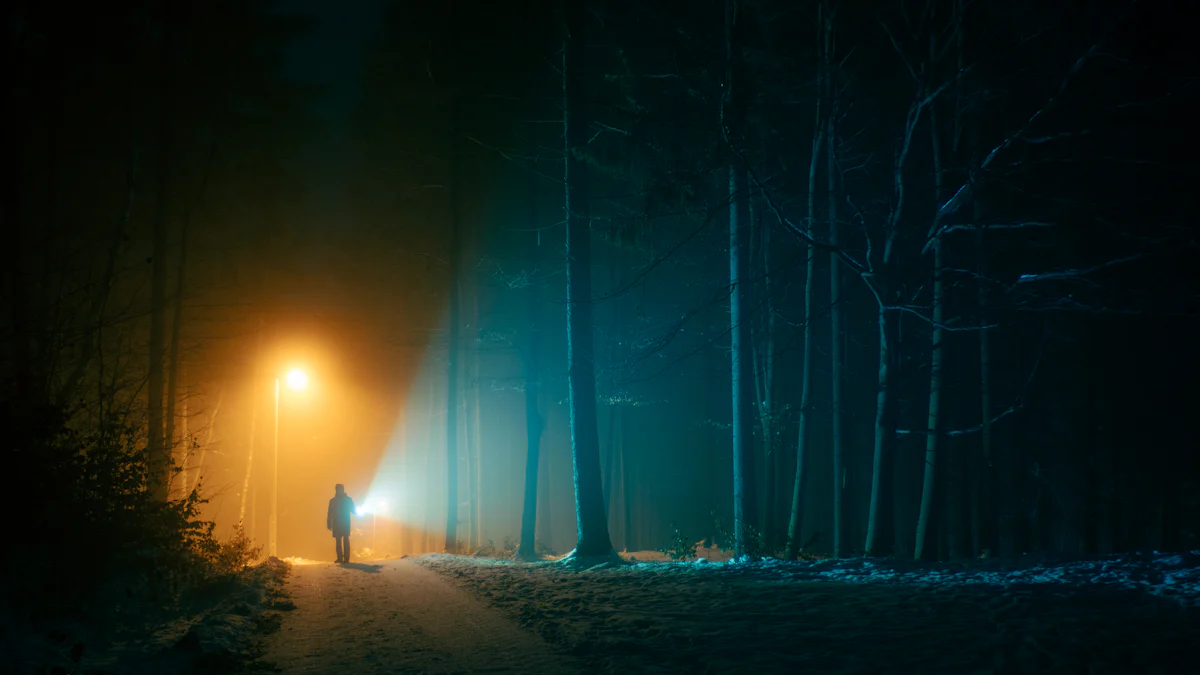Essential Flashlights for Nighttime Fishing Adventures

When you're out on the water after sunset, having the right flashlights for fishing can make all the difference. It’s not just about seeing in the dark—it’s about staying safe, finding the perfect fishing spot, and improving your chances of success. A reliable flashlight helps you navigate tricky terrain, avoid hazards like rocks, and even signal for help if needed. Plus, it makes spotting fish and bait much easier, so you can cast with precision.
Fishing flashlights are designed specifically for outdoor conditions. Unlike general-purpose models, they’re built to handle wet environments, offer longer runtimes, and often include multiple light modes. Whether you need a headlamp for hands-free use or a waterproof flashlight for underwater tasks, there’s a perfect option for every angler. With the right flashlights for fishing, your nighttime fishing adventures become safer, more efficient, and a lot more enjoyable.
Key Takeaways
Pick a flashlight with 200 lumens or more for clear vision at night.
Choose waterproof ones with a high IPX rating for wet weather.
Use headlamps to keep your hands free while fishing.
Get flashlights with adjustable brightness to save battery and fit different needs.
Clean and test your flashlight before trips to make sure it works well.
Best Flashlights for Fishing at Night

High-Performance Flashlights
Features and benefits of high-lumen flashlights
When you're fishing at night, a high-performance flashlight can be your best companion. These flashlights are designed to deliver maximum lumen output, ensuring you have bright and reliable illumination. Whether you're casting your line or navigating the shoreline, the right flashlight helps you see clearly and stay safe.
Here’s what makes high-lumen flashlights stand out:
Brightness and Lumens: High-lumen counts provide intense light, perfect for spotting fish or obstacles.
Beam Distance and Spread: A long-range beam helps you scan the water, while a wide spread illuminates your surroundings.
Battery Life: Long-lasting batteries ensure your flashlight doesn’t die in the middle of your fishing trip.
Durability: Built to withstand drops and rough handling, these flashlights are ideal for outdoor adventures.
Recommended models like the Fenix HT18 and PD36R Pro for maximum brightness and range
If you're looking for the best flashlights for fishing, consider the Fenix HT18 and PD36R Pro. The HT18 offers incredible brightness and a long beam throw, making it perfect for spotting fish from a distance. The PD36R Pro, on the other hand, combines high performance with portability, offering adjustable brightness settings and a rechargeable battery. Both models are durable and reliable, ensuring they can handle the challenges of nighttime fishing.
Waterproof and Submersible Flashlights
Importance of waterproofing for fishing environments
Fishing environments are unpredictable. Water splashes, rain, or even accidental drops into the water can happen. That’s why waterproof flashlights are essential. They maintain functionality in wet conditions, ensuring you’re never left in the dark. Plus, they’re built to last, withstanding rough handling and harsh weather.
Pro Tip: Look for flashlights with a high IPX rating, like IPX5 or higher, for the best water resistance.
Best options like the Nitecore MH12 V2 for underwater or wet conditions
The Nitecore MH12 V2 is a top choice for anglers. It’s waterproof, durable, and offers a powerful beam, making it perfect for wet conditions. With its compact design and long battery life, this flashlight is a reliable tool for any fishing adventure.
Compact and Portable Flashlights
Why portability matters for fishing trips
When you’re carrying gear for a fishing trip, every ounce counts. Compact and portable flashlights are lightweight and easy to pack, making them ideal for anglers on the move. They’re perfect for tasks like setting up your gear, navigating the water’s edge, or checking your bait.
Lightweight and easy-to-carry flashlight recommendations such as the LA Gear Recon Rechargeable Flashlight
The LA Gear Recon Rechargeable Flashlight is a standout option. It’s small but mighty, offering 1,000 lumens of light with a 300-meter beam throw. With a runtime of up to 40 hours on its lowest setting, this flashlight is both powerful and practical. Its waterproof design and multiple modes make it a versatile tool for any fishing trip.
Headlamps for Hands-Free Fishing
Advantages of using headlamps for nighttime fishing
When you're out fishing at night, a headlamp can be a game-changer. Unlike traditional flashlights, headlamps free up your hands so you can focus entirely on fishing. Imagine being able to cast your line, reel in a catch, or adjust your bait without juggling a flashlight. Sounds convenient, right?
Here’s why headlamps are perfect for nighttime fishing:
They let you use both hands for tasks like tying knots or handling your gear.
The light shines directly from your forehead, so it always points where you're looking.
You don’t have to worry about holding or adjusting a separate flashlight, making it easier to move around.
Most headlamps are lightweight and adjustable, so they stay comfortable even during long fishing trips.
Pro Tip: Choose a headlamp with adjustable brightness settings. This way, you can switch between a focused beam for spotting fish and a softer light for general tasks.
Top-rated headlamps for comfort and functionality
Not all headlamps are created equal. For nighttime fishing, you need one that’s durable, waterproof, and bright enough to light up your surroundings. Here are some top-rated options:
Black Diamond Storm 400: This headlamp is a favorite among anglers. It’s waterproof, durable, and offers red, green, and blue light options to preserve your night vision.
DanForce Rechargeable Headlamp: With 1,080 lumens of brightness, this headlamp is incredibly powerful. It’s rechargeable via USB, waterproof, and even includes a secondary red light for added versatility.
Energizer Rechargeable LED Headlamp PRO: If you’re looking for something affordable yet reliable, this headlamp is a great choice. It’s bright, rechargeable, and works well in various conditions.
When choosing a headlamp, look for features like white and red light settings, at least 400 lumens of brightness, and a rechargeable battery. These features ensure your headlamp performs well, even in challenging conditions.
Note: Rechargeable headlamps are especially handy during cold weather since disposable batteries can lose power quickly in low temperatures.
Key Factors to Consider When Choosing a Fishing Flashlight
Brightness and Beam Distance
How to determine the right brightness level for fishing (e.g., 80 lumens or higher)
Choosing the right brightness level for your fishing flashlight is crucial. You want enough light to see clearly without overwhelming your surroundings. For general fishing, a flashlight with 200 to 500 lumens works well. If you're fishing in deeper waters or need to spot fish from a distance, go for a higher lumen count. Brightness not only improves visibility but also helps you navigate safely and locate fish more effectively.
Some flashlights even come with red light modes. These are great for attracting fish without scaring them away. So, if you're planning a fishing trip, consider a flashlight with adjustable brightness settings to suit different situations.
The importance of beam distance for spotting fish and obstacles
Beam distance plays a big role in how effective your flashlight is. A longer beam helps you spot fish, obstacles, or even your fishing line in the dark. Here's a quick guide to beam distance based on lumens:
Lumens | Distance | Best For |
|---|---|---|
1–250 | Up to 80 meters | Everyday and leisure activities in dim conditions |
160–400 | Up to 100 meters | Camping, hiking, backpacking |
400–1000 | Up to 200 meters | Hiking, backpacking, caving, campervan engine repair |
1000–30000 | Up to 350 meters | Fishing, hunting, rock climbing |
3000–70000 | Up to 500 meters | Extreme weather conditions, mountaineering, emergency rescue |
7000–15000 | Up to 700 meters | Extreme weather conditions, emergency rescue, mountaineering, activities that require lighting a large area |
For nighttime fishing, aim for a flashlight with at least 400 lumens and a beam distance of 200 meters or more. This ensures you can see clearly and avoid hazards.
Battery Life and Power Source
Rechargeable vs. disposable batteries: Pros and cons
When it comes to powering your fishing flashlight, you have two main options: rechargeable or disposable batteries. Each has its pros and cons:
Rechargeable Batteries:
Higher power capacity, ideal for high-drain flashlights.
Cost-effective over time since you don't need frequent replacements.
Environmentally friendly due to their long lifespan.
Disposable Batteries:
Lightweight and easy to carry as spares.
No need for electricity, making them reliable during power outages.
Lower upfront cost compared to rechargeable options.
If you're going on a long fishing trip, rechargeable batteries are a great choice. Just make sure to charge them fully before heading out.
Tips for ensuring long-lasting battery performance
To get the most out of your flashlight's battery, follow these tips:
Use the lowest brightness setting when full power isn't necessary.
Turn off the flashlight when not in use.
Store batteries in a cool, dry place to prevent damage.
Carry spare batteries or a portable charger for emergencies.
Durability and Build Quality
Materials to look for in a durable flashlight
Fishing environments can be tough, so you need a flashlight that can handle the challenge. Look for models made from high-quality materials like aircraft-grade aluminum or stainless steel. These materials resist drops, water exposure, and general wear and tear.
Flashlights designed to withstand harsh fishing conditions
Some of the best flashlights for fishing are built specifically for rugged use. They feature reinforced casings, waterproof seals, and shock-resistant designs. These flashlights ensure reliability, even in extreme conditions. When choosing a flashlight, prioritize durability to avoid any mishaps during your fishing adventures.
Waterproofing and Weather Resistance
Understanding IP ratings for water resistance
When you're fishing at night, water is everywhere—on your hands, your gear, and sometimes even in the air. That’s why understanding IP ratings is so important when choosing the best flashlights for your adventures. These ratings tell you how well a flashlight can resist water and dust.
Here’s a quick breakdown of what the numbers mean:
The second digit in an IP rating shows water resistance, ranging from 0 (no protection) to 8 (maximum protection).
For example, an IPX4 flashlight can handle splashes from any direction, but it’s not fully waterproof.
An IPX7 flashlight can survive being submerged in water up to one meter for 30 minutes.
Always check the manufacturer’s specifications to know the limits of your flashlight. Even the most water-resistant models have boundaries.
Why weatherproofing is essential for outdoor use
Fishing environments are unpredictable. One moment it’s calm, and the next, you’re dealing with rain or splashes. A weatherproof flashlight ensures you’re never left in the dark.
Here’s why it matters:
Waterproof flashlights stay reliable in wet conditions, maintaining consistent brightness.
They’re built to handle sudden weather changes, unlike non-waterproof options.
Dependable lighting is crucial when you’re outdoors, especially during nighttime fishing.
With a weatherproof flashlight, you can focus on catching fish instead of worrying about your gear.
Additional Features
Red light modes for preserving night vision
Have you ever noticed how bright white light can ruin your night vision? That’s where red light modes come in handy. They let you see clearly without overwhelming your eyes or scaring away fish.
Red light is perfect for tasks like tying knots or checking your gear. It’s also less likely to attract bugs, making your fishing experience more comfortable. Look for flashlights with this feature to enhance your nighttime fishing trips.
Adjustable brightness settings for versatility
Not every situation calls for the same level of brightness. Adjustable settings let you switch between high, medium, and low modes based on your needs.
Here’s how it works:
Brightness Level | Lumens | Battery Life |
|---|---|---|
High | 250 | 6 Hours |
Medium | 125 | 13 Hours |
Low | 10 | 90 Hours |
High brightness is great for spotting fish or navigating tricky terrain. Medium works well for general tasks, while low saves battery during downtime. This flexibility makes adjustable flashlights a must-have for fishing.
Pro Tip: Use lower brightness settings when you don’t need full power. It extends battery life and keeps your flashlight ready for when you need it most.
Tips for Using Flashlights for Fishing Effectively

Positioning and Angling the Light
How to avoid glare and maximize visibility
Positioning your flashlight correctly can make a big difference during your fishing trip. You want to avoid glare that could blind you or reflect off the water. Instead, angle the light downward or to the side to reduce harsh reflections. This setup helps you see clearly without straining your eyes.
Another tip is to use a flashlight with adjustable brightness. Lower the intensity when you’re working close to your gear and increase it when scanning the water. This approach keeps your visibility sharp while conserving battery life.
Tips for illuminating your fishing area without scaring fish
Lighting your fishing area effectively without scaring fish requires a bit of strategy. Fish are sensitive to sudden bright lights, so you need to be subtle.
"Hanging the light beneath the surface is more effective than transom-mounted lights... A submerged light broadcasts steadily in all directions, and creates a shadow line and plenty of ambush points for pelagics."
Here’s how you can do it:
Use submersible lights to maximize light dispersion and effectiveness.
Position multiple lights at different locations to cover a broader area.
Activate lights before dark to attract baitfish and larger fish.
Maintain a quiet approach to minimize disturbances and avoid scaring fish.
By following these steps, you’ll create an inviting environment for fish while keeping your fishing flashlight effective.
Maintaining Your Fishing Flashlight
Cleaning and storing your flashlight after use
After every fishing trip, clean your flashlight to keep it in top condition. Wipe it down with a damp cloth to remove dirt, salt, or water residue. For waterproof models, rinse them under fresh water to prevent corrosion. Once clean, dry the flashlight thoroughly before storing it in a cool, dry place. Proper storage ensures it’s ready for your next adventure.
Checking batteries and functionality before each trip
Before heading out, always check your flashlight’s batteries and functionality. Test the light to ensure it’s working properly. If you’re using rechargeable batteries, charge them fully. For disposable batteries, carry spares in case of emergencies. A quick pre-trip check can save you from unexpected issues during your fishing trip.
Choosing the right fishing flashlight can transform your nighttime fishing experience. It’s not just about seeing in the dark—it’s about staying safe, spotting fish, and making your fishing trip more enjoyable. When selecting a flashlight, focus on key features like brightness, beam distance, and battery life. Durable, water-resistant designs are also essential for handling outdoor conditions.
Top recommendations like the Fenix HT18 or Nitecore MH12 V2 offer exceptional performance, while headlamps like the Black Diamond Storm 400 provide hands-free convenience. Investing in a reliable flashlight ensures you’re prepared for any situation, making your next fishing adventure safer and more successful.
Pro Tip: A flashlight with adjustable brightness and red light mode can enhance your fishing experience even further.
FAQ
What type of flashlight is best for nighttime fishing?
You’ll want a durable, waterproof flashlight with adjustable brightness. A high-lumen model helps you see clearly, while red light modes preserve your night vision. Compact designs or headlamps are great for hands-free use. Choose one that suits your fishing style and environment.
How do I maintain my fishing flashlight?
After each trip, clean your flashlight with a damp cloth to remove dirt or salt. Rinse waterproof models under fresh water, then dry them thoroughly. Store it in a cool, dry place. Always check the batteries before your next outing to ensure it’s ready to go.
Can I use any flashlight for fishing?
Not all flashlights are suitable for fishing. Regular models may lack waterproofing or durability. Fishing flashlights are designed for wet environments and often include features like long battery life, adjustable brightness, and weather resistance. Investing in the right one makes your experience safer and more enjoyable.
Why is red light important for fishing?
Red light preserves your night vision and doesn’t scare fish away. It’s perfect for tasks like tying knots or checking gear. Plus, it attracts fewer bugs compared to white light. Many fishing flashlights include this feature for added convenience during nighttime fishing.
How bright should my flashlight be for fishing?
For nighttime fishing, aim for a flashlight with at least 200 lumens. This provides enough brightness to see clearly without overwhelming your surroundings. If you’re fishing in deeper waters or need to spot fish from a distance, go for a higher lumen count.
See Also
Experience Night Fishing Comfortably Using a Headlamp
SF1 Flashlight: Brighten Up Your Camping Experiences
Why Hunting Flashlights Are Crucial for Outdoor Lovers
